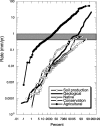Soil erosion and agricultural sustainability
- PMID: 17686990
- PMCID: PMC1948917
- DOI: 10.1073/pnas.0611508104
Soil erosion and agricultural sustainability
Abstract
Data drawn from a global compilation of studies quantitatively confirm the long-articulated contention that erosion rates from conventionally plowed agricultural fields average 1-2 orders of magnitude greater than rates of soil production, erosion under native vegetation, and long-term geological erosion. The general equivalence of the latter indicates that, considered globally, hillslope soil production and erosion evolve to balance geologic and climate forcing, whereas conventional plow-based agriculture increases erosion rates enough to prove unsustainable. In contrast to how net soil erosion rates in conventionally plowed fields ( approximately 1 mm/yr) can erode through a typical hillslope soil profile over time scales comparable to the longevity of major civilizations, no-till agriculture produces erosion rates much closer to soil production rates and therefore could provide a foundation for sustainable agriculture.
Conflict of interest statement
The author declares no conflict of interest.
Figures





References
-
- Marsh GP. Man and Nature; or, Physical Geography as Modified by Human Action. New York: Scribner; 1864.
-
- Lowdermilk WC. Conquest of the Land Through 7,000 Years. Washington, DC: US Department of Agriculture; 1953.
-
- Dale T, Carter VG. Topsoil and Civilization. Norman, OK: Univ of Oklahoma Press; 1955.
-
- Judson S. Science. 1968;160:1444–1446. - PubMed
-
- Pope KO, van Andel TH. J Archaeol Sci. 1984;11:281–306.
LinkOut - more resources
Full Text Sources

